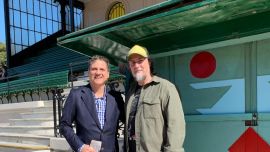Massive overdrafts are taken by dieting Treasuries that follow fortunes made and lost in a timing that is no more than a blink in history.
The experience is called a crisis. Happens from time to time, as we well know. Brazil is in financial and social crisis, just like us here. So it was appropriate to visit Manaus, which once went from fortune to famine yet had been envisioned and funded to become a Paris (that’s what they called it) in the tropical forest. Why not? Buenos Aires was the Paris and Uruguay was the Switzerland of South America at one time. But we’ve stayed in the dumps, even if now we are to be called “emerging.”
The idea of Manaus with streets of gold was dreamed up by squillionaires who saw the money flow in from the production of rubber, the “white gold,” in volumes the size of the Negro river, on whose banks the city stands. Men made millions in just about two decades and in the two more after that the rubber boom out of Brazil went bust. The heyday lasted from 1870 to 1912, when bankruptcy reduced the great city with a golden future to little more than a squat with some big buildings. The financial crash of Manaus reverberated throughout Brazil with the world near to the eve of the Great War.
Fact is, I was more interested in Manaus itself, its urban history and the records of some of its buildings. But it is so fashionable nowadays to talk about crises or sound knowledgeable about market blow-outs that it seemed the right thing to look back on historic dampers and entertaining failures. I’ll get back to the subject of my choice, which is about special sites in Manaus in the next few weeks if I’m still in business, of course.
The end in Brazil happened when the rubber market that funded Manaus and a lot of Brazil, was defeated by plantations of seedlings which began to prosper in other parts. The ground turned out to be better elsewhere, even though the original rubber tree seed was born in Brazil, hence the name of hevea brasiliensis. But it soon spread with the advantage of natural improvements in distant soil.
Manaus (or Manaos, choose the spelling) today is a smallish city at about 2.2 million souls with a booming fish market, some industry, substantial tourist attractions and the beautiful Amazon Opera House (more about that when I’m through with this better-timed report).
In the early 1870s, it was an Englishman (who else in the Victorian age of imperial expansion?), one Sir Henry Alexander Wickham, described in biographical dictionaries as an explorer and bio-pirate (Crónica would love this, if they read English) who took out of Brazil something in the region of 70,000 rubber plant seeds (the figure is pure literature, nobody appears to have counted that many). It was not a theft, as Wickham originally described his baggage to hype his own profile as an adventurer, but a shipment without hindrance permitted under current legal exchanges of plant varieties. (Documented research on this was provided by professor Warren Dean, NYU professor of history, who made his case in the New York Times on December 28, 1988.) Brazil at that time was still ruled by Dom Pedro II, albeit in the last decade of his reign, and the descendants of the court of Braganza. The British government saw the Portuguese, including those in “the court of the Brazils,” as ancient and respected allies.
The seeds were sent to the Kew Botanical Gardens in South London, there to be planted and cherished, but more successfully to one Henry Nicholas Ridley, the director of the Singapore Botanic Gardens. Ridley stuffed his pockets with rubber seeds and shoved them at every person he saw who was found to have a garden in which they could try to grow the mystery plant. The first nine plants grew large and healthy by 1877, nurtured in what was then known as the Malay Federated States, later to become independent Malaysia.
In Manaus, tour guides doubling as botanists who were consulted said that the seeds were not easily grown anywhere else. The Malaysian territory had and probably does to this day, a deeper source of rich top soil compared to that of the Amazon forest, which is equally rich but shallower. This disadvantage in Brazil, though longknown, appears to have come into full light when vast deforestation got under way in the forties to clear the jungle for farming and population spreads. Then it was realized that the invaders had access to all the land they could settle, but it would take years to achieve the fertility required for mass development. At the current rate of devastation, the Matto Grosso is almost a suburban gardener’s source of little Christmas trees.
Hence, the end of the Brazilian rubber boom, and the beginning of the financial crisis, was not a product of the theft of seeds but a result of greed, which is the usual way these crises happen as well we know in Argentina. The Brazilian rubber barons sold and exported as fast as they could to face up to their new competitors in South East Asia. All other cash crops were pushed aside: rubber products were in demand in what would be known in future as consumer market proportions. On the other side of the world and encouraged by the British Empire’s commercial reaches, the Malayan rubber growers shipped as much and as fast as the European markets required.
From there on the glut grew and the prices dropped dramatically. Britain created a cartel and Brazil was left out. The financial disaster in Manaus, and elsewhere, had arrived. The crisis grew with World War I. There was rubber aplenty, but Germany was boycotted, and the Germans were soon working on substitutes.




















Comments